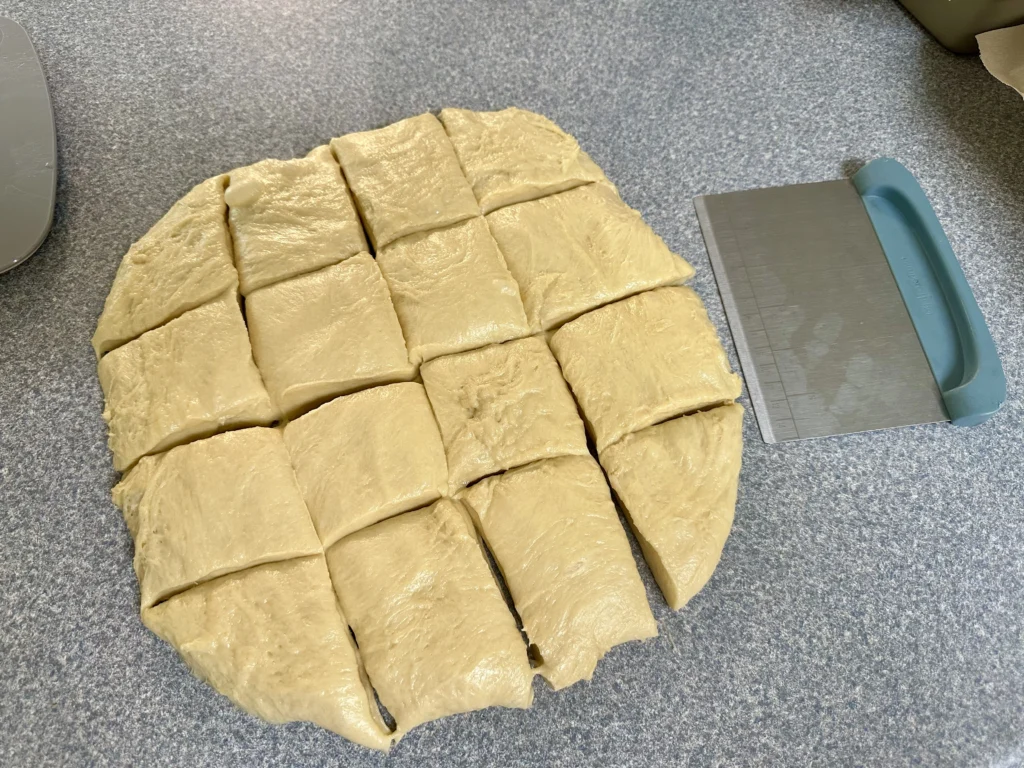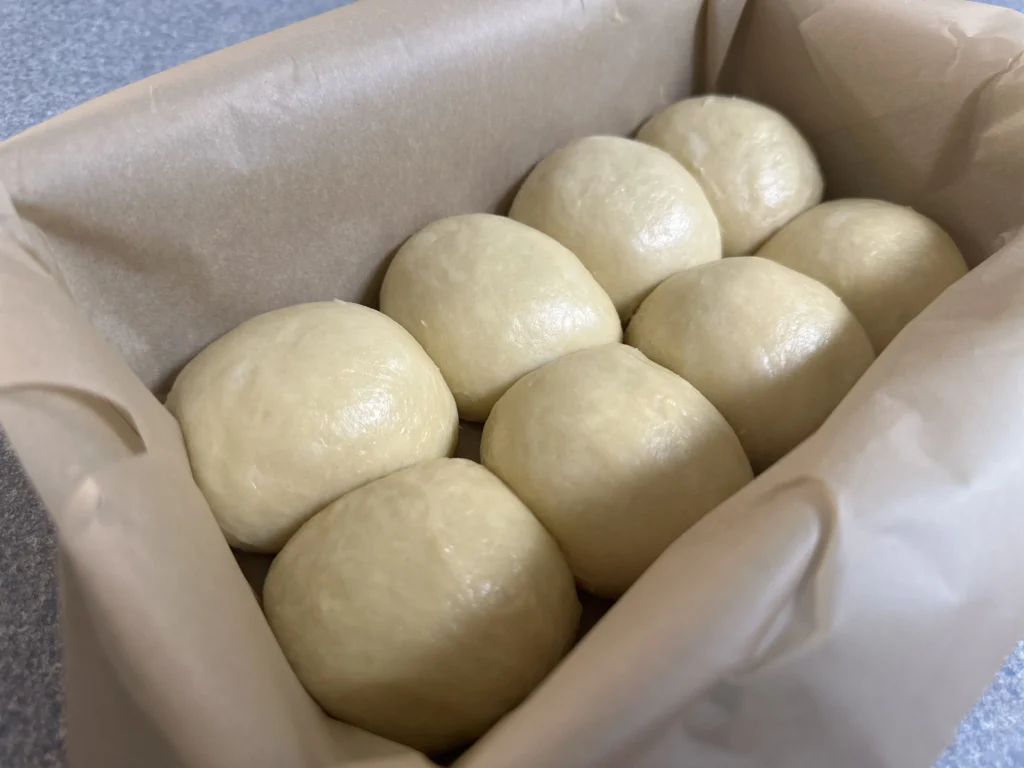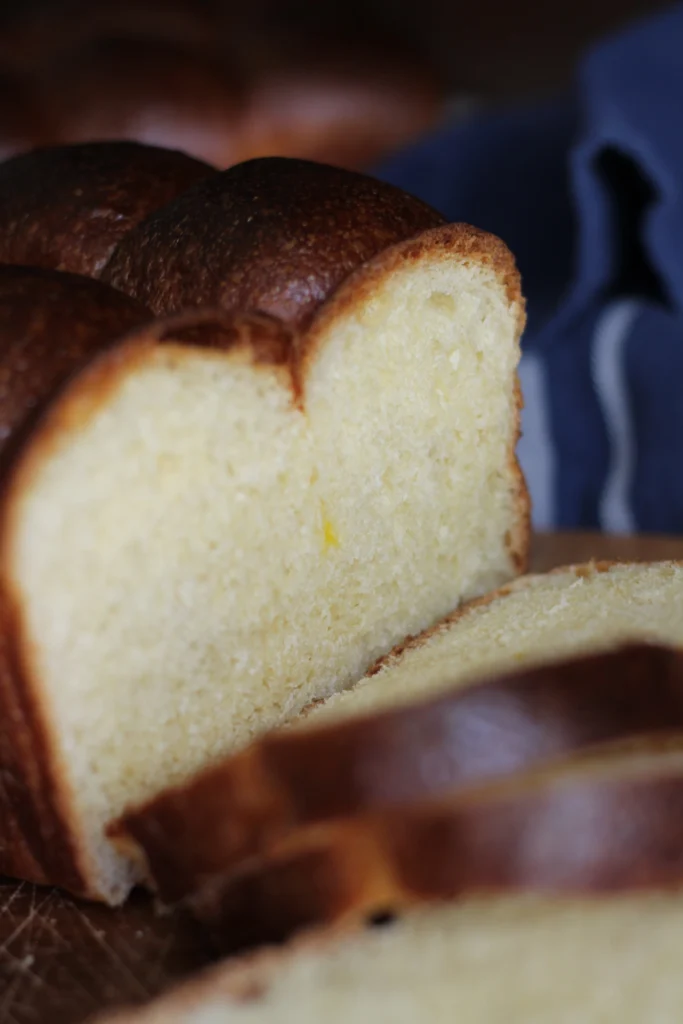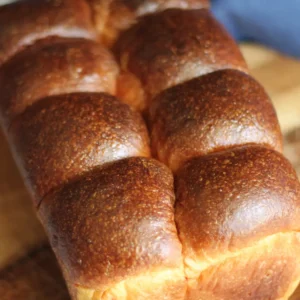It’s hard to pass up a good slice of potato flake sourdough brioche. It’s soft, buttery, and almost melts in your mouth with every bite. Using a potato flake sourdough starter preserves that sweet flavor and naturally rises your bread.

This recipe takes a little time, but the result is a rich, fluffy loaf that’s perfect for Sunday breakfast, holiday gatherings, or even just an everyday slice, toasted, spread with jam next to your morning coffee.
Why Use Potato Flake Sourdough?
If this is your first time using a potato flake starter you might be wondering what’s so special about potato flake sourdough? It’s dependable, mild in flavor, and adds that perfect balance without overwhelming the richness of the bread. In brioche, it gives a lift and complexity that commercial yeast alone just can’t match.
Now, if you’ve been baking along with me for a while, you already know I love working with potato flake sourdough starter. Did you know that not only does potato flake starter give this brioche a light, fluffy texture, but the long fermentation process also makes the bread easier to digest and more nutrient-rich? As the dough rests and rises, the wild yeast breaks down gluten and antinutrients in the grains, helping your body absorb more of the good stuff while giving the bread a beautifully soft crumb.
This post may contain affiliate links through amazon, which means I may make a small commission at no extra cost to you. When you make a purchase through my link, you help me to keep Little Tennessee Home up and running! Thank you for your support! See my full disclosure here.
Tools Needed
- Stand mixer with dough hook (or strong arms if kneading by hand)
- Mixing bowl with cover (plastic wrap, beeswax wrap, or a tight lid)
- Bench scraper (for dividing and shaping dough easily)
- Two loaf pans
- Parchment Paper
- Pastry brush (for applying the egg wash)
- Measuring cups and spoons
- Kitchen scale (optional, but highly recommended for accuracy)
Ingredients
- 3/4 cup active potato flake starter (193 g)
- 3 cups of bread flour (420 g)
- 1 3/4 cup unbleached all-purpose flour (237 g)
- 1/4 cup sugar (48 g)
- 4 large eggs
- 1 1/2 teaspoons salt (8 g)
- 1/2 cup whole milk (108 g)
- 2 sticks butter, room temperature (226 g)
For the Egg Wash:
- 1 large egg
- 1 tablespoon water
Instructions to Make Potato Flake Sourdough Brioche
Prep the Starter
Feed your starter about 12 hours before you plan to make this recipe. This gives it plenty of time to get nice and active.
Mix the Dough

Combine all of the ingredients in the bowl of a stand mixer. Knead on medium speed until the dough becomes smooth and glossy.


This will take about 10–15 minutes. The dough is very wet at first—resist the urge to add more flour. It will come together with time.
First Rise (bulk fermentation)

Cover bowl with plastic wrap, beeswax wrap, or a tight-fitting lid. Let it rise in a warm spot for about 8 hours, or until doubled in size.
Chill the Dough

Place the risen dough in the refrigerator for at least a few hours (or overnight). Chilling makes the sticky dough much easier to handle when it’s time to shape.
Divide and Shape
Prepare your pan by either greasing well, or lining with parchment paper.


Turn the chilled dough onto a clean surface and divide into two equal portions (a bench scraper works great for this). Cut each half into eight pieces, giving you a total of 16. Shape each into a ball.
Pan the Dough

Use 8 pieces of dough in each bread pan. Place each dough ball into each parchment-lined loaf pan. Cover and let rise again until doubled—this will take 6–8 hours, or you can leave it overnight.
Bake

Preheat the oven to 425°F. Make the egg wash by whisking together the egg and water. Brush the top of the dough in each pan.

Bake loaves for 15 minutes, then loosely cover with foil to prevent over-browning.
Continue baking another 10 minutes, until the brioche is golden brown and baked through (about 25 minutes total).

Allow to cool in the pan for about 5 minutes and then remove to finishing cooling on a wire rack.
Notes & Tips
- This is a wet dough. Don’t add extra flour, no matter how tempting it is—it’s the secret to that soft, fluffy texture.
- If you don’t have bread flour, you can use all-purpose, though bread flour gives it a little more structure.
- You may be able to make this dairy-free with plant-based milk and vegan butter (though I haven’t tested it myself).
Serving Ideas
This brioche is delicious all on its own, but it also makes the most incredible French toast, bread pudding, or even sandwiches if you want to elevate your lunch. Honestly though, a warm slice with butter and jam is all it really needs.
How to Use Leftover Brioche
If you’re lucky enough to have leftovers, here are some of the best ways to enjoy them:
- French Toast: Brioche soaks up custard beautifully, making it the ultimate base for French toast and french toast muffin cups.
- Bread Pudding: Cube it up, mix with eggs, milk, and sugar, and bake for a cozy dessert.
- Gourmet Sandwiches: Ham and cheese or chicken salad sandwiches are next-level on brioche.
- Crostini or Croutons: Slice, toast, and top with savory spreads—or cube and bake for salads.
- Freezer Prep: Slice and freeze for quick breakfasts or lunchbox sandwiches later on.
- Savory Strata – Layer brioche cubes with eggs, cheese, and veggies for a dinner-worthy bake.
- Soup Companion – Toasted brioche makes the ultimate topper for hearty stews and chowders.

Storage and Freezing
- Room Temperature: Store your brioche in an airtight container or tightly wrapped in plastic wrap. It will stay fresh for about 2–3 days on the counter.
- Refrigeration: You can refrigerate brioche, but it tends to dry out faster. If you do, make sure it’s well wrapped and bring it back to room temperature before serving.
- Freezing: Brioche freezes beautifully! Wrap the cooled loaf (or individual slices) tightly in plastic wrap, then place in a freezer bag. It will keep well for up to 3 months.
- Reheating: To enjoy frozen brioche, thaw it at room temperature. You can refresh slices in the toaster or pop the whole loaf in a 325°F oven for 10–15 minutes.
Troubleshooting
My dough is too sticky to handle.
This dough is naturally wet. If it feels unworkable, chill it longer—cold dough is much easier to shape. Resist adding flour, or you’ll lose the fluffy texture.
My brioche didn’t rise.
Make sure your potato flake starter was active before mixing the dough. Also, give the dough plenty of time in a warm, draft-free spot—sometimes it just needs more patience.
The top of my loaf browned too quickly.
Every oven is different. If your brioche darkens before it’s fully baked, tent it loosely with foil earlier in the bake.
The bread tastes dense instead of light and airy.
This can happen if the dough wasn’t kneaded enough or if it didn’t rise long enough. Next time, let the stand mixer run the full 10–15 minutes and give the dough ample time to double.

FAQ
Can I make brioche without a stand mixer?
Yes, but it’s a workout! The dough is very sticky, so kneading by hand will take longer (15–20 minutes). A stand mixer makes it much easier.
Can I refrigerate the dough longer than overnight?
Yes. The dough can stay in the refrigerator for up to 48 hours, which actually helps develop even more flavor. Just be sure to shape and let it rise fully before baking.
Can I use all-purpose flour instead of bread flour?You can! Bread flour gives brioche a little more strength and structure, but all-purpose flour will still give you a delicious, soft loaf.
What’s the difference between potato flake sourdough and regular sourdough starter in brioche?Potato flake starter is mild and slightly sweet, making it perfect for an enriched bread like brioche. A traditional flour-and-water sourdough starter can be used, but it will give the bread a stronger, more tangy flavor (sour taste). If you don’t have a potato starter you can check out my starter recipe on how to make your own starter, or you can convert your existing starter instead of having to make a new starter.
Can I use all-purpose flour instead of bread flour?
Yes! If you don’t have bread flour, you can use all-purpose. Just know that bread flour has a higher protein content, which helps the gluten develop and gives brioche its signature structure. That little extra protein is what makes the bread rise taller and stay extra soft.
Can I cover with a tea towel instead?
The reason I don’t recommend using a tea towel is because the top of the dough can dry out since the dough rises for a long time. The best thing to use is something that holds in the moisture. Plastic wrap, beeswax wrap, or a tight fitting lid are perfect for this.
Baker’s Timeline
Want to know when to start each step? Here’s a simple schedule to keep your baking day stress-free:
- Night Before (8–9 PM): Feed your potato flake starter so it’s active in the morning.
- Morning of the next day (8 AM): Mix dough in stand mixer and knead until smooth. Let rise in a warm spot.
- Afternoon (4 PM): Dough should be doubled—chill for a few hours (or overnight).
- Evening (7 PM): Shape dough into balls, place in pans, cover, and let rise again.
- Next Morning (7 AM): Loaves should be puffy and ready to bake—perfect timing for a fresh breakfast brioche!
Variations
Once you’ve mastered the classic loaf, you can use this same dough to create all kinds of treats:
- Brioche Dinner Rolls – Instead of shaping into loaves, divide into 24 equal portions, roll into balls, and place in a greased 9×13 pan. Bake until golden for pull-apart dinner rolls.
- Chocolate Chip Brioche – Knead in 1–1 ½ cups mini chocolate chips during the last few minutes of mixing for a sweet twist.
- Cinnamon Swirl Brioche – Roll out the dough after chilling, sprinkle with a mixture of cinnamon and sugar, then roll back up before placing in the loaf pans.
- Fruit-Stuffed Brioche – Add dried cranberries, raisins, or chopped dried apricots for little bursts of sweetness in every bite.
- Savory Brioche – Reduce the sugar to 2 tablespoons and knead in shredded cheese, fresh herbs, or garlic for a loaf that pairs beautifully with soups and pastas.
- Brioche Buns – Shape into 8 larger rounds for the softest, richest hamburger or sandwich buns you’ll ever eat.

What Makes Brioche Different from Regular Bread?
Brioche isn’t your typical loaf of sandwich bread. While most sandwich breads rely mainly on flour, water, active dry yeast, and salt, brioche is enriched with eggs, butter, milk, and a touch of sugar. All of that richness creates a soft, tender crumb and a slightly sweet flavor that makes it taste more like a cross between bread and pastry.
The high fat content is also what gives brioche its beautiful golden color and pillowy texture. In short—it’s bread that feels a little extra fancy, but still completely doable at home.
Challah vs. Brioche
Challah and brioche may seem similar—they’re both enriched, slightly sweet breads—but they have some key differences. Brioche is rich with butter, eggs, and sometimes milk, giving it a tender, almost pastry-like crumb. Challah contains eggs and a bit of sugar, but much less butter, so it’s slightly lighter with a firmer, chewier texture.
Brioche leans richer and buttery, while challah has a subtly sweet flavor with more emphasis on the natural bread notes. Brioche is often used for sweet applications like French toast or dessert breads, whereas challah works well for both sweet and savory dishes, from sandwiches to bread pudding.
Challah is traditionally braided, giving it a striking appearance, while brioche can be braided, shaped into loaves, or formed into buns, offering more flexibility for creative shapes. In short, challah is lighter and chewier, and brioche is richer and more tender—both are delicious and versatile breads you can make using your potato flake starter.
Pin for later and share with a friend

If you give this recipe a try, I would greatly appreciate if you came back and gave it a 5-star review! It helps me out so much!
I also love seeing all of the delicious creations you make! Share your photo over on instagram or facebook and give me a tag @littletennesseehome

Potato Flake Sourdough Brioche
Equipment
- Stand mixer with dough hook (or strong arms if kneading by hand)
- Mixing bowl with cover (plastic wrap, beeswax wrap, or a tight lid)
- Bench scraper (for dividing and shaping dough easily)
- Two loaf pans
- Parchment Paper
- Pastry brush – For applying the egg wash.
- measuring cups and spoons
- Kitchen scale (optional, but highly recommended for accuracy)
Ingredients
- 3/4 cup active potato flake starter 193 grams
- 3 cups bread flour 420 grams
- 1 3/4 cup unbleached all-purpose flour 237 grams
- 1/4 cup sugar 48 g
- 4 large eggs
- 1 1/2 teaspoons salt 8 grams
- 1/2 cup whole milk 108 grams
- 2 softened sticks butter (226 g)
For the Egg Wash:
- 1 large egg
- 1 tablespoon water
Instructions
- Feed your starter about 12 hours before you plan to make this recipe. This gives it plenty of time to get nice and active.
- Combine all of the ingredients in the bowl of a stand mixer. Knead on medium speed until the dough becomes smooth and glossy. This will take about 10–15 minutes. The dough is very wet at first—resist the urge to add more flour. It will come together with time.
- Cover bowl with plastic wrap, beeswax wrap, or a tight-fitting lid. Let it rise in a warm spot for about 8 hours, or until doubled in size.
- Place the risen dough in the refrigerator for at least a few hours (or overnight). Chilling makes the sticky dough much easier to handle when it’s time to shape.
- Prepare your pan by either greasing well, or lining with parchment paper. Turn the chilled dough onto a clean surface and divide into two equal portions (a bench scraper works great for this). Cut each half into eight pieces, giving you a total of 16. Shape each into a ball.
- Use 8 pieces of dough in each bread pan. Place each dough ball into each parchment-lined loaf pan. Cover and let rise again until doubled—this will take 6–8 hours, or you can leave it overnight.
- Preheat the oven to 425°F. Make the egg wash by whisking together the egg and water. Brush the top of the dough in each pan.
- Bake loaves for 15 minutes, then loosely cover with foil to prevent over-browning.
- Continue baking another 10 minutes, until the brioche is golden brown and baked through (about 25 minutes total). Allow to cool in the pan for about 5 minutes and then remove to finishing cooling on a wire rack.

Leave a Reply